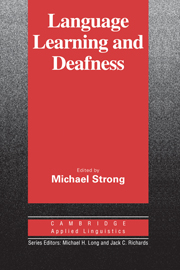Book contents
- Frontmatter
- Contents
- List of contributors
- Series editors' preface
- Preface
- SECTION I THEORETICAL ISSUES
- Chapter 1 Language varieties in the deaf population and their acquisition by children and adults
- Chapter 2 American Sign Language and the human biological capacity for language
- Chapter 3 The history of language use in the education of the Deaf in the United States
- Chapter 4 Sign language instruction and its implications for the Deaf
- Chapter 5 A bilingual approach to the education of young deaf children: ASL and English
- SECTION II RESEARCH REPORTS
- Index
Chapter 5 - A bilingual approach to the education of young deaf children: ASL and English
Published online by Cambridge University Press: 05 October 2012
- Frontmatter
- Contents
- List of contributors
- Series editors' preface
- Preface
- SECTION I THEORETICAL ISSUES
- Chapter 1 Language varieties in the deaf population and their acquisition by children and adults
- Chapter 2 American Sign Language and the human biological capacity for language
- Chapter 3 The history of language use in the education of the Deaf in the United States
- Chapter 4 Sign language instruction and its implications for the Deaf
- Chapter 5 A bilingual approach to the education of young deaf children: ASL and English
- SECTION II RESEARCH REPORTS
- Index
Summary
Editor's introduction
One educational approach that has never been attempted officially with deaf children is bilingual education. Uncertainties about whether ASL constitutes a language and about the number of children who learn that language at home, the lack of trained teachers who know ASL, and the fact that it has no written form, in conjunction with negative feelings in general about bilingual education, probably account for the reluctance to try it with the deaf. This chapter describes a pioneering effort to design and execute an experimental bilingual curriculum for young deaf children. The justification for adopting a bilingual educational approach for this special population is threepronged: Evidence from existing research has shown the alternatives to be unsuccessful, Cummins's linguistic interdependence model provides theoretical support, and findings from an earlier observational study of residential school children has shown that children from both hearing and deaf families use more ASL-like structures than English forms in their spontaneous language.
There follows a brief description of the experimental curriculum, which uses a storytelling format first to introduce ASL into the classroom and later to teach English through the medium of ASL. Emphasis is on both language learning and the enhancement of metalinguistic awareness. This program, although limited, is the first of its kind to be researched and evaluated in the United States.
- Type
- Chapter
- Information
- Language Learning and Deafness , pp. 113 - 130Publisher: Cambridge University PressPrint publication year: 1988
- 9
- Cited by



